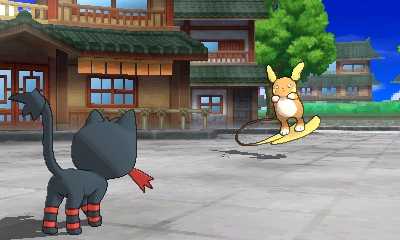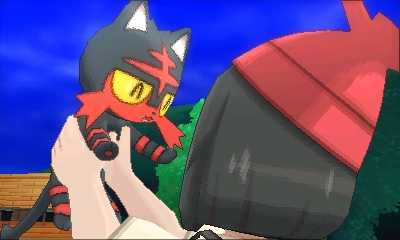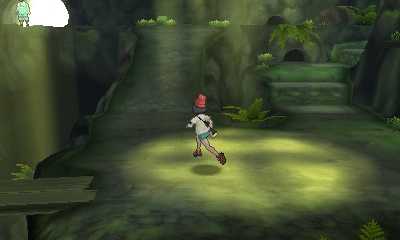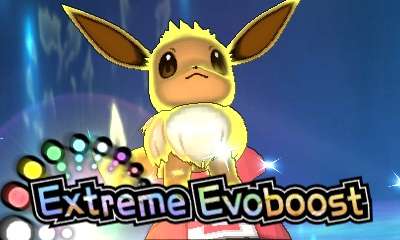Evolution is one of the key tenets of Pokémon . As your monsters grow and level up, they eventually transform into bigger, more powerful creatures, opening up new move sets and methods of play. And yet for years, Pokémon as a series has been growing stale. For the past two decades, it's been the same old adventure, the same old gym battles and the same old final showdown with the Elite Four at the end, leaving the last 24 games feeling pretty much the same as the one that came before it.
Change, however, is finally at hand, as Pokémon Sun and Moon represent the biggest leap forward in the series' history. It's as dramatic as Magikarp evolving into Gyarados, or ugly-mug Feebas shape-shifting into the sublime Milotic. This is Pokémon as you've never played it before, and it makes the franchise as a whole all the better for it.
Your main goal still involves catching 'em all and being the best like no-one ever was, but this Hawaii-inspired island adventure completely rewrites the Pokémon rule book. Gym battles are out, badges are gone, and even the famed Elite Four Pokémon League HQ is still under construction. Heck, you don't even have a bike.

Instead, you'll be tearing up the dirt tracks (in a full, fluid 360 degrees, I might add) on your very own Tauros, one of the brand-new Ride Pokémon you can call on from your Poké Pager. Tauros isn't just a faster means of travel, either: his charge attack can also crush rocks, opening up new areas that in previous games would have required a Pokémon who knew Rock Smash.
Sniffer-dog Stoutland also doubles up as your faithful Dowsing Machine, allowing you to uncover hidden items around your environment, while Charizard and Lapras are on Fly and Surf duty. This effectively banishes the need for HM (or Hidden Machine) slaves – those sad, ever-present Pokémon you begrudgingly drag everywhere with you just to cut, smash or strong-arm your way through caves and jungles – allowing you to finally focus on building a team that's truly your own rather than one that feels constrained by your current environment.
Indeed, when you catch a new Pokémon in Sun and Moon, you now get the option of adding them to your party there and then, swapping them in for one of your current 'mon rather than waiting until you get to the next Pokémon centre. Not only does this newfound freedom to change your team on the fly make the game feel much more elastic and dynamic, but the ability to view their stats and moveset means you're also much more informed about each capture. It takes the guessing game out of hunting down particular natures or abilities, streamlining the whole process.
This sense of openness extends to Sun and Moon's revamped battle screen as well. Now I know that menu tweaks are hardly the sexiest of game topics, but I'm not overexaggerating when I say Sun and Moon have really outdone themselves here. In addition to seeing your Pokémon appear in all their beautifully animated glory on the top screen, for instance, you'll also find small sprite versions of them on the touchscreen.

Tap them and you'll see each 'mon's HP, type, ability and stats, the latter of which have five small triangles next to them to show whether any buffs or debuffs have been applied. It's incredibly nerdy, but when previous games forced you to hold all this information in your head, the chance to see it all there in front of you comes as a huge relief for those who haven't been quite so studious on the latest Pokémon developments.
Add in new indicators denoting which moves are super-effective and information buttons for each individual attack – something that in previous games would have involved tapping through dozens of menu screens – and Sun and Moon are easily the most accessible Pokémon games yet, catering to long-time fans as well as complete newcomers.

Ditching the gym-leader structure does wonders for the game's pacing, too. They still exist in a very loose sense – here they have the title of "Kahuna" – but instead of simply rocking up to a new town and adding yet another shiny badge to your collection, Sun and Moon see you tackling specific trails that play out across each of Alola's four main islands.
Trials form the backbone of your journey. Some incorporate a bit of light puzzling, while others introduce you to new mechanics, but all of them work toward making your journey feel more organic, as though you're traversing these islands for a reason rather than simply trudging from town A to town B. It gives Alola a much greater sense of place than either Kanto or Johto, and the smooth, swooping camera angles and lush 3D environments put the rigid and rather static corridors of Kalos to shame.
Completing a trial gives you a much more tangible reward, too. Defeat the area's super-powered "Totem Pokémon", for instance, and you'll be presented with an elemental Z-Crystal. These allow your Pokémon to dole out a flashy, once-per-battle Z-Move, making them much more useful prizes than any gym badge.

It's the smaller, more personal touches that really seal the deal, though. Thanks to its revamped affection system, known here as Pokémon Refresh, Pokémon you have the strongest bond with will now glance back at you with a reassuring "I got this" nod each time you summon them in battle, and you in turn cheer them in the text box on as they fight. Occasionally they might even avoid certain attacks or shake themselves out of crippling status effects, reinforcing the idea you're fighting as a real team rather than issuing orders to bits of data.
With such an exhaustive overhaul of its core systems, Sun and Moon are, quite literally, like night and day compared to the rest of the series. They're a resounding transformation, and have managed to achieve what I once thought was impossible – having grown out of the series around the time of Black and White, Sun and Moon have somehow managed to put me firmly back on the Pokémon bandwagon again, making me more excited than ever to get my team back together again. It might have taken 20 years and 24 games to get here, but these are easily the best Pokémon games to date. Whether you're a fresh-faced newcomer, a stalwart veteran or simply a lapsed, casual fan, there's never been a better time to return to the world of Pokémon.











